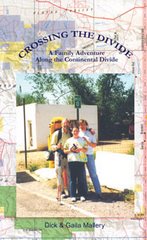
I spent two days in Pie Town, New Mexico. The trail north from Pie Town is a dirt road that meanders through scrubland for about fifty miles leading to the El Malpais Wilderness.
There was no traffic on the road and few cattle. I could sing to myself at the top of my lungs and offend no one. Occasionally, I would spy a windmill to the east or west and migrate over to fill my containers.
"Don’t go through that El Malpais Wilderness. People have been known to go in there and never be heard from again." Those were the words of one old-timer in Pie Town. I assumed he was exaggerating. Everything he described sounded far-fetched. I realized I would have to deal with sharp lava rock, but deep, bubble-shaped holes you could never climb out of and crevasses that would swallow you up didn’t seem realistic.
The area is actually known as the Badlands "El Malpais", one of the best examples of recent volcanic landscapes U.S. Here the trail coincides with the 1,000-year-old Zuni-Acoma trade route, crossing rugged lava flows.
I had the opportunity to skirt the whole area. A 20-mile dirt road called the Seven Crater Byway detoured El Malpais. Articles I had read advised against hiking through this area. A day after entering this land of lava, I questioned my judgment of not staying on the road. The trail into the El Malpais quickly turned into a faint path and, eventually, game trails.
I found water just before the boundary and filled every container I had. It was the last water I would find for the next 24 hours. Some of the old-timers’ tales were beginning to make sense to me. Lava tubes, ancient crevasses and deep holes with interiors shaped like bubbles were common formations throughout this region.
Looking into these openings, I could see the skeletal remains of animals that had fallen in and did not escape. It was slow, tedious hiking around the mounds and cones of uplifted lava formations. I kept working my way northwest, trying to exit the wilderness near a forest service road that would lead me to Grants, New Mexico.
Becoming familiar with your surroundings often takes longer than a thru-hiker can afford. It was reasonable to assume that water was nearby because I could see signs of abundant wildlife.
Late in the afternoon on my second day in the badlands, I entered a campground area and a trailhead to well-known lava tubes. I was optimistic that I would find water available in the camping area but no such luck. I began following a road leading west. My only hope was to intersect the bypass or a ranch where I could find a livestock tank. I didn’t have to wait that long. An hour up the road, I ran into the trail magic I so desperately needed. A couple by the name of Ott from Austin, Texas, pulled up next to me in their SUV. They were headed in the toward the campground for a couple days of mountain biking. They had five gallons of water and offered me all I wanted. I cannot explain exactly what transpired when I met people like the Otts along the lonely stretches of this trail, but it was magical. After spending just a few minutes with complete strangers, I would be completely energized. I would pick up my pace, feel stronger, forget my blistered feet and concentrate on my next route objective. It was apparent each time I met someone. It seemed as though I had been plugged in and recharged. It felt wonderful!
Excerpt from "Crossing the Divide, A Family Adventure Along the Continental Divide--MALLERYBOOKS.COM
Some additional El Malpais information:
This sweet segment of the 3,100-mile Continental Divide National Scenic Trail (CDT) meets any definition
of remote you care to set. The closest town, Pie Town, a booming metropolis at 2,900 souls, has tempted thru-hikers on the CDT with a slogan, "Days go on, life goes by, and that’s why you should stop for pie!"
After a serving of famous "New Mexico Apple Pie," you’ll be ready to explore the geologic anomaly that is the Chain of Craters. The Chain of Craters is located within the El Malpais National Conservation Area and borders the El Malpais National Monument. Both areas lie in the high desert southwest of Albuquerque. Spanish for "The Badlands," the El Malpais region has figured in Acoma, Laguna, Zuni, and Ramah Navajo Native American cultures for thousands of years. Their ancestral uses–gathering herbs and medicines, paying respect, and renewing ties to their ancestors–continue today.
Within the National Monument the CDT shares a path with the Zuni-Acoma Trail, an ancient route connecting the pueblos of Zuni and Acoma Native Americans, which has witnessed more than 1,000 years of human travel and use. In fact, many of the rock cairns and lava bridges built by the Ancestral Puebloans are still used to mark the route today.
This unique landscape also provides for a depth and breadth of wildlife diversity uncommon to the surrounding area. This segment of trail makes for nearly 20 miles of classic high desert backpacking. Water is very scarce on this section, and daytime temperatures can easily reach the triple digits in the summer. Those unaccustomed to this climate should make sure to hydrate well and consume some salty snacks, thereby avoiding dehydration and its fatal opposite, hyponatremia, an imbalance between the body’s water and electrolytes.
This remote segment of the Continental Divide National Scenic Trail traverses a unique "volcanic badlands" across the high desert of northern New Mexico. Prepare for a long, waterless trek over fields of purple-black lava, past the ancient calderas of the volcanoes that created this arid marvel of a trail. The inspiring views of Cerro Lobo and Cerro Brillante mountains will be your reward.
There was no traffic on the road and few cattle. I could sing to myself at the top of my lungs and offend no one. Occasionally, I would spy a windmill to the east or west and migrate over to fill my containers.
"Don’t go through that El Malpais Wilderness. People have been known to go in there and never be heard from again." Those were the words of one old-timer in Pie Town. I assumed he was exaggerating. Everything he described sounded far-fetched. I realized I would have to deal with sharp lava rock, but deep, bubble-shaped holes you could never climb out of and crevasses that would swallow you up didn’t seem realistic.
The area is actually known as the Badlands "El Malpais", one of the best examples of recent volcanic landscapes U.S. Here the trail coincides with the 1,000-year-old Zuni-Acoma trade route, crossing rugged lava flows.
I had the opportunity to skirt the whole area. A 20-mile dirt road called the Seven Crater Byway detoured El Malpais. Articles I had read advised against hiking through this area. A day after entering this land of lava, I questioned my judgment of not staying on the road. The trail into the El Malpais quickly turned into a faint path and, eventually, game trails.
I found water just before the boundary and filled every container I had. It was the last water I would find for the next 24 hours. Some of the old-timers’ tales were beginning to make sense to me. Lava tubes, ancient crevasses and deep holes with interiors shaped like bubbles were common formations throughout this region.
Looking into these openings, I could see the skeletal remains of animals that had fallen in and did not escape. It was slow, tedious hiking around the mounds and cones of uplifted lava formations. I kept working my way northwest, trying to exit the wilderness near a forest service road that would lead me to Grants, New Mexico.
Becoming familiar with your surroundings often takes longer than a thru-hiker can afford. It was reasonable to assume that water was nearby because I could see signs of abundant wildlife.
Late in the afternoon on my second day in the badlands, I entered a campground area and a trailhead to well-known lava tubes. I was optimistic that I would find water available in the camping area but no such luck. I began following a road leading west. My only hope was to intersect the bypass or a ranch where I could find a livestock tank. I didn’t have to wait that long. An hour up the road, I ran into the trail magic I so desperately needed. A couple by the name of Ott from Austin, Texas, pulled up next to me in their SUV. They were headed in the toward the campground for a couple days of mountain biking. They had five gallons of water and offered me all I wanted. I cannot explain exactly what transpired when I met people like the Otts along the lonely stretches of this trail, but it was magical. After spending just a few minutes with complete strangers, I would be completely energized. I would pick up my pace, feel stronger, forget my blistered feet and concentrate on my next route objective. It was apparent each time I met someone. It seemed as though I had been plugged in and recharged. It felt wonderful!
Excerpt from "Crossing the Divide, A Family Adventure Along the Continental Divide--MALLERYBOOKS.COM
Some additional El Malpais information:
This sweet segment of the 3,100-mile Continental Divide National Scenic Trail (CDT) meets any definition
of remote you care to set. The closest town, Pie Town, a booming metropolis at 2,900 souls, has tempted thru-hikers on the CDT with a slogan, "Days go on, life goes by, and that’s why you should stop for pie!"
After a serving of famous "New Mexico Apple Pie," you’ll be ready to explore the geologic anomaly that is the Chain of Craters. The Chain of Craters is located within the El Malpais National Conservation Area and borders the El Malpais National Monument. Both areas lie in the high desert southwest of Albuquerque. Spanish for "The Badlands," the El Malpais region has figured in Acoma, Laguna, Zuni, and Ramah Navajo Native American cultures for thousands of years. Their ancestral uses–gathering herbs and medicines, paying respect, and renewing ties to their ancestors–continue today.
Within the National Monument the CDT shares a path with the Zuni-Acoma Trail, an ancient route connecting the pueblos of Zuni and Acoma Native Americans, which has witnessed more than 1,000 years of human travel and use. In fact, many of the rock cairns and lava bridges built by the Ancestral Puebloans are still used to mark the route today.
This unique landscape also provides for a depth and breadth of wildlife diversity uncommon to the surrounding area. This segment of trail makes for nearly 20 miles of classic high desert backpacking. Water is very scarce on this section, and daytime temperatures can easily reach the triple digits in the summer. Those unaccustomed to this climate should make sure to hydrate well and consume some salty snacks, thereby avoiding dehydration and its fatal opposite, hyponatremia, an imbalance between the body’s water and electrolytes.
This remote segment of the Continental Divide National Scenic Trail traverses a unique "volcanic badlands" across the high desert of northern New Mexico. Prepare for a long, waterless trek over fields of purple-black lava, past the ancient calderas of the volcanoes that created this arid marvel of a trail. The inspiring views of Cerro Lobo and Cerro Brillante mountains will be your reward.












No comments:
Post a Comment